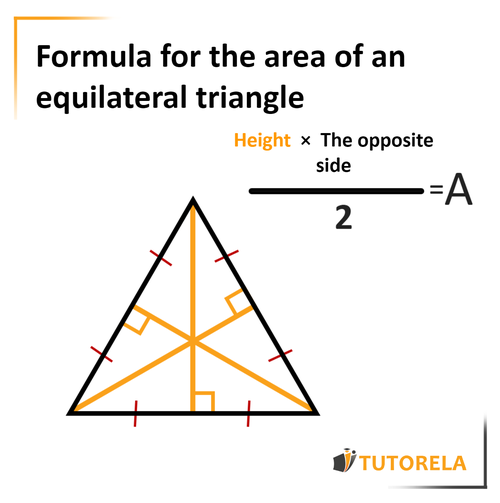Formula to calculate the area of an equilateral triangle:

Master calculating equilateral triangle area with step-by-step practice problems. Learn to use height, median, and bisector properties in triangle geometry.
Formula to calculate the area of an equilateral triangle:

Calculate the area of the following triangle:
Complete the sentence:
To find the area of a right triangle, one must multiply ________________ by each other and divide by 2.
To solve this problem, begin by identifying the elements involved in calculating the area of a right triangle. In a right triangle, the two sides that form the right angle are known as the legs. These legs act as the base and height of the triangle.
The formula for the area of a triangle is given by:
In the case of a right triangle, the base and height are the two legs. Therefore, the process of finding the area involves multiplying the lengths of the two legs together and then dividing the product by 2.
Based on this analysis, the correct way to complete the sentence in the problem is:
To find the area of a right triangle, one must multiply the two legs by each other and divide by 2.
Answer:
the two legs
Calculate the area of the right triangle below:
Due to the fact that AB is perpendicular to BC and forms a 90-degree angle,
it can be argued that AB is the height of the triangle.
Hence we can calculate the area as follows:
Answer:
24 cm²
Calculate the area of the triangle using the data in the figure below.
To solve the problem of finding the area of triangle , we follow these steps:
Let's go through each step in detail:
Step 1: From the figure, the base and height .
Step 2: The formula for the area of a triangle is: .
Step 3: Substituting the known values into the formula, we get:
Therefore, the area of triangle is 10.
Answer:
10
Calculate the area of the triangle below, if possible.
To solve this problem, we begin by analyzing the given triangle in the diagram:
While the triangle graphic suggests some line segments labeled with the values "7.6" and "4", it does not confirm these as directly usable as pure base or height without additional proven inter-contextual relationships establishing perpendicularity or side/unit equivalences.
Without a clear base and perpendicular height value, we cannot apply the triangle's area formula effectively, nor do we have all side lengths for Heron's formula.
Therefore, due to insufficient information that specifically identifies necessary dimensions for area calculations such as clear height to a base or all sides' measures, the area of this triangle cannot be calculated.
The correct answer to the problem, based on insufficient explicit calculable details, is: It cannot be calculated.
Answer:
It cannot be calculated.
Calculate the area of the triangle below, if possible.
The formula to calculate the area of a triangle is:
(side * height corresponding to the side) / 2
Note that in the triangle provided to us, we have the length of the side but not the height.
That is, we do not have enough data to perform the calculation.
Answer:
Cannot be calculated